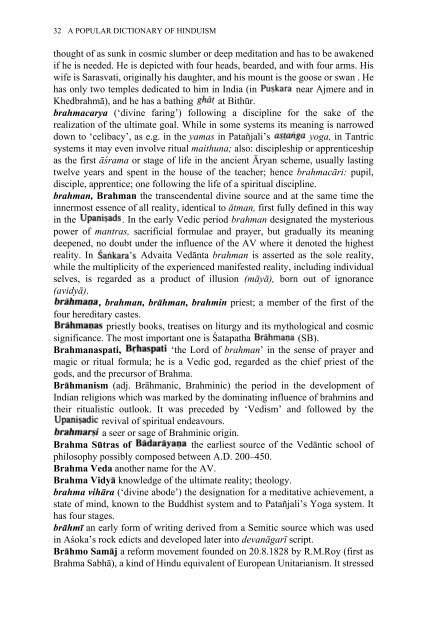You also want an ePaper? Increase the reach of your titles
YUMPU automatically turns print PDFs into web optimized ePapers that Google loves.
32 A POPULAR DICTIONARY OF HINDUISM<br />
thought <strong>of</strong> as sunk in cosmic slumber or deep meditation and has to be awakened<br />
if he is needed. He is depicted with four heads, bearded, and with four arms. His<br />
wife is Sarasvati, originally his daughter, and his mount is the goose or swan . He<br />
has only two temples dedicated to him in India (in near Ajmere and in<br />
Khedbrahmā), and he has a bathing at Bithūr.<br />
brahmacarya (‘divine faring’) following a discipline for the sake <strong>of</strong> the<br />
realization <strong>of</strong> the ultimate goal. While in some systems its meaning is narrowed<br />
down to ‘celibacy’, as e.g. in the yamas in Patañjali’s yoga, in Tantric<br />
systems it may even involve ritual maithuna; also: discipleship or apprenticeship<br />
as the first āśrama or stage <strong>of</strong> life in the ancient Āryan scheme, usually lasting<br />
twelve years and spent in the house <strong>of</strong> the teacher; hence brahmacāri: pupil,<br />
disciple, apprentice; one following the life <strong>of</strong> a spiritual discipline.<br />
brahman, Brahman the transcendental divine source and at the same time the<br />
innermost essence <strong>of</strong> all reality, identical to ātman, first fully defined in this way<br />
in the . In the early Vedic period brahman designated the mysterious<br />
power <strong>of</strong> mantras, sacrificial formulae and prayer, but gradually its meaning<br />
deepened, no doubt under the influence <strong>of</strong> the AV where it denoted the highest<br />
reality. In Advaita Vedānta brahman is asserted as the sole reality,<br />
while the multiplicity <strong>of</strong> the experienced manifested reality, including individual<br />
selves, is regarded as a product <strong>of</strong> illusion (māyā), born out <strong>of</strong> ignorance<br />
(avidyā).<br />
, brahman, brāhman, brahmin priest; a member <strong>of</strong> the first <strong>of</strong> the<br />
four hereditary castes.<br />
priestly books, treatises on liturgy and its mythological and cosmic<br />
significance. The most important one is Śatapatha (SB).<br />
Brahmanaspati,<br />
‘the Lord <strong>of</strong> brahman’ in the sense <strong>of</strong> prayer and<br />
magic or ritual formula; he is a Vedic god, regarded as the chief priest <strong>of</strong> the<br />
gods, and the precursor <strong>of</strong> Brahma.<br />
Brāhmanism (adj. Brāhmanic, Brahminic) the period in the development <strong>of</strong><br />
Indian religions which was marked by the dominating influence <strong>of</strong> brahmins and<br />
their ritualistic outlook. It was preceded by ‘Vedism’ and followed by the<br />
revival <strong>of</strong> spiritual endeavours.<br />
a seer or sage <strong>of</strong> Brahminic origin.<br />
Brahma Sūtras <strong>of</strong><br />
the earliest source <strong>of</strong> the Vedāntic school <strong>of</strong><br />
philosophy possibly composed between A.D. 200–450.<br />
Brahma Veda another name for the AV.<br />
Brahma Vidyā knowledge <strong>of</strong> the ultimate reality; theology.<br />
brahma vihāra (‘divine abode’) the designation for a meditative achievement, a<br />
state <strong>of</strong> mind, known to the Buddhist system and to Patañjali’s Yoga system. It<br />
has four stages.<br />
brāhmī an early form <strong>of</strong> writing derived from a Semitic source which was used<br />
in Aśoka’s rock edicts and developed later into devanāgarī script.<br />
Brāhmo Samāj a reform movement founded on 20.8.1828 by R.M.Roy (first as<br />
Brahma Sabhā), a kind <strong>of</strong> Hindu equivalent <strong>of</strong> European Unitarianism. It stressed


















